The Germans weren't first onto the SUV bandwagon, but they've made up for this by offering more of them than anyone else. With the recent addition of the X4, BMW offers five different SUV models (or crossovers, if you prefer that term for the car-based sort), with at least one more on the way. I've previously reviewed the subcompact X1 and the compact X3. For 2014 BMW has redesigned its first SUV, the midsize X5.
I planned to review a third-generation X5 with BMW's latest 255-horsepower diesel engine, since sampled in the 535d sedan (and compared to the Mercedes-Benz E250). But the diesels arrived well after the others. So, bearing in mind that I said I didn't want to review the 300-horsepower xDrive35i, the press fleet company scheduled a 445-horsepower V8-powered X5 xDrive50i.
Initially, this seemed fortuitous, as I was also scheduled to review a Range Rover Sport Supercharged, with a 510-horsepower V8. Land Rover doesn't offer its diesels in the U.S., at least not yet. V8-to-V8 would keep things apples-to-apples.
Then the Range Rover Sport showed up with a 340-horsepower supercharged V6.
The V8 Range Rover Sport also has a more handling-oriented suspension. So the substitution of the V6 risked a repeat of the last time I compared these two models, around the time the Land Rover was introduced as a 2006 model. The "Sport" suffix led me to expect tight and precise handling on par with the decidedly driver-oriented first-gen BMW X5's. Instead I discovered a ponderous vehicle that heeled over in turns nearly as much as the LR3 on which it was based. Sporty when off the road, perhaps, but certainly not on one.
This repeat didn't happen. First up I'll review the third-generation BMW X5. Next, the second-generation Land Rover Range Rover Sport.
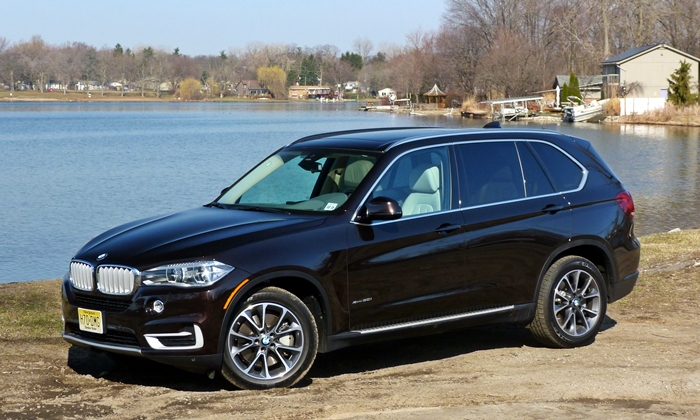
Bulkier nose, lower roof, less muscular fenders make for a more generic BMW X5. more X5 photos
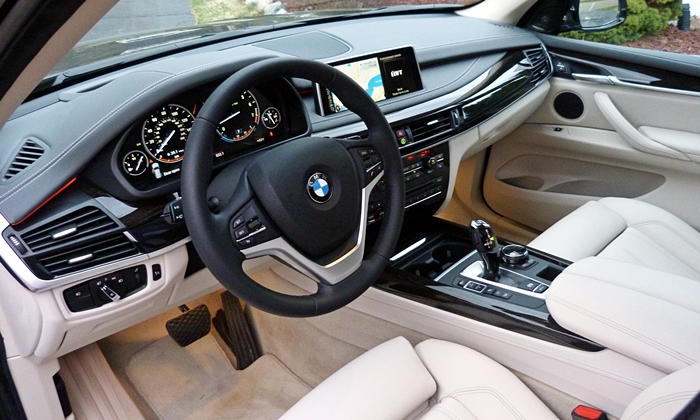
Interior styling and materials are both very BMW.
| |
Compared to the Range Rover Sport |
| Powertrain performance |
 Better
Worse
Better
Worse
|
I've found the performance of the 300-horsepower xDrive35i (tested in the previous generation) well beyond adequate. I similarly found the 340-horsepower Range Rover Sport HSE to be satisfyingly quick. But if you want your tall, wide, two-and-a-half-ton conveyance to be brutally quick, then step up to a V8. Don't let the X5's on-paper power shortfall fool you. BMW tends to under-rate its engines, and the X5 is about as quick (if not quicker) than a Range Rover Sport with the same cylinder count. The V8s can get from a dead stop to 60 mph in about five seconds.
The BMW engines make less mechanical noise, and generally sound and feel smoother. But if you appreciate a clearly audible burble from the exhaust, you'll get it with the BMW V8. Munich likely figured that V8 buyers want to hear the additional cylinders for which they're paying $4,700--each--and fits a sport exhaust as standard equipment.
| Front seat support & comfort |
 Better
Worse
Better
Worse
|
BMW's multicontour seats, a $1,300 option on six-cylinder X5s and standard with the V8, deliver a rarely matched combination of support in turns and comfort on long drives. In a reversal of traditional tendencies, the buckets in the Range Rover Sport feel firmer and less comfortable.
Though you'll find a commanding view forward in either driver seat, the Range Rover Sport maintains an edge in this area. Unusually large windows are one thing that makes a Land Rover a Land Rover.
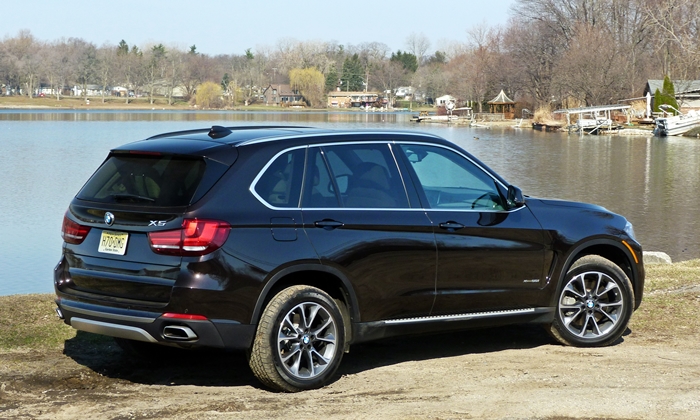
Rear side window kink, L-shaped LED tail lamps identify the new X5 as a current BMW.
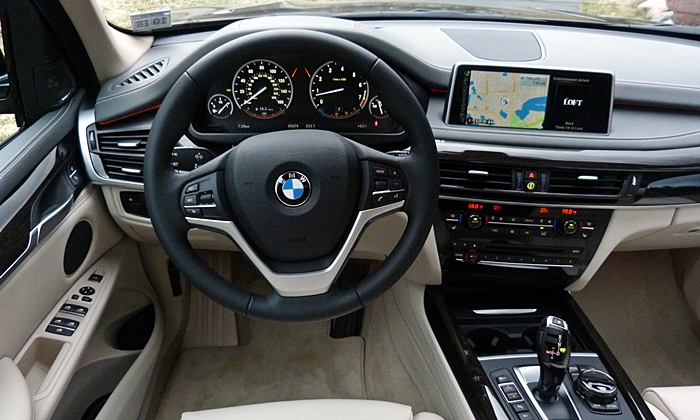
As in other recently redesigned BMWs, the infotainment display looks like it retracts, but doesn't.
| Ride smoothness |
 Better
Worse
Better
Worse
|
The first-generation X5, tuned to deliver the handling people then expected from a BMW, sought to pound bumps into submission rather than absorbing them. The second-generation X5 rode less harshly without sacrificing handling, at least when fitted with the newly optional adaptive dampers (which firm up only when this is necessary). The third-generation X5 rides much like the latest Mercedes-Benz M-Class, which is to say smoothly. Even with its adaptive dampers set to "sport" the new X5 pounds much less firmly across road imperfections than its predecessors.
| Quietness |
 Better
Worse
Better
Worse
|
The new X5 also rides very quietly, too, aside from the aforementioned exhaust burble.
| |
Compared to the Range Rover Sport |
| Handling |
 Better
Worse
Better
Worse
|
Unfortunately, the surprises dealt by the new X5's suspension tuning aren't all positive. Expecially with the adaptive dampers set to "comfort," the suspension permits far too much body motion. Though the tested X5, when pushed, eventually took a set and then handled curves with admirable balance and composure, initially it felt sloppy and unwieldy. It seeks to have two personalities, and the transition from Dr. Jekyl to Mr. Hyde isn't a seamless one.
It probably didn't help that the tested X5 was fitted with active steering, a $1,550 option. This system varies the steering ratio based on vehicle speed and other factors. In this application it's far too light and quick given the dimensions of the vehicle and the output of the engine. Between the relatively soft suspension, the ultra-quick feel-free steering, and the explosive V8, the tested X5 seemed overly eager to leap ahead of its capabilities. Or at least ahead of mine. It was a confidence-killing handful. I enjoyed driving the Range Rover Sport far more despite (or perhaps even partly because of) its far less powerful engine.
This said, the tested X5, while an X Line equipped with the active steering and adaptive dampers, was not fitted with the sport suspension (part of the M Sport Line, $4,600 with a six or $3,600 with the V8) or active stabilizer bars (which would further reduce roll, for an additional $4,500 in a package with the adaptive dampers and an active rear differential). At least the former seems mandatory if you want your X5 to handle like a BMW.
For performance and handling beyond even an X5 xDrive50i with all of these boxes checked, a new X5 M should be just around the corner.
| Rear seat room & comfort |
 Better
Worse
Better
Worse
|
Audi and Mercedes both offer much longer SUVs. At least until BMW fields an X7, the X5 is available with an optional third-row seat. Especially considering the size and price of the X5, said third row is absurdly tight, thinly upholstered, and difficult to access. The door openings are small, and the entire second row seat pivots forward and upward off the floor in an only partially successful attempt to compensate. To provide even minimal legroom for those using it, the second row must slide forward a few inches, to the point that its occupants find their own legroom severely compromised. Both rows are too low to the floor for adult comfort.
The third-row seat optional in the Range Rover Sport probably isn't much better, and deletes the spare tire (not available on the BMW regardless). This might explain why it wasn't on the tested vehicle. If you want a usable third row, Land Rover offers the less stylish, but also much less expensive and roomier LR4.
Shift focus to the second-row seat, and I found that in the smaller X3 at least as comfortable, and easier to get into and out of thanks to the more compact vehicle's lower ride height. That in the Range Rover Sport, though also not the roomiest or the most comfortable, is better than the X5's.
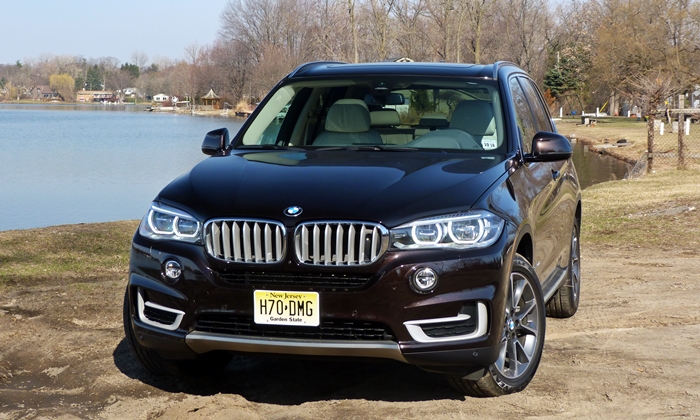
The kidneys can't get much wider. Body side bulges much reduced.
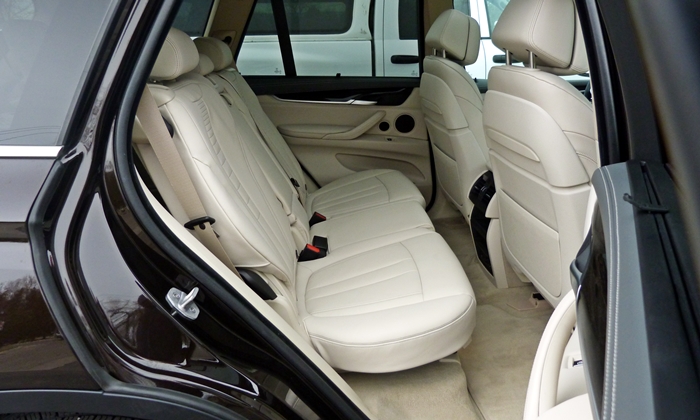
The X5's rear seat is too low. Also tight if slid forward to enable the 3rd row.
| Exterior styling |
 Better
Worse
Better
Worse
|
The first- and second-generation BMW X5s, though no beauty queens, were attractive in the way that heavily muscled athletes are attractive. In comparison, the 2014's exterior, though it remains instantly recognizable as that of an X5, has the looser proportions, less muscular haunches, and less imposing stance of a run-of-the-mill, transverse-powertrained people hauler. The also new-for-2014 Toyota Highlander comes to mind, partly because it borrows more than a bit from BMW's design language, but also for less defensible reasons. The X5's characteristic fender bulges have been slimmed down, perhaps in pursuit of greater packaging efficiency or broader market appeal. And BMW has sacrificed yet another previously tight front overhang on the altar of European pedestrian safety regulations. It could be worse. The latest Mercedes-Benz M-Class suffers along the same lines to an even greater extent. Yet the new Range Rover Sport, which must comply with the same regulations, is even more attractive than its comely predecessor.
| |
Compared to the Range Rover Sport |
| Fuel economy |
 Better
Worse
Better
Worse
|
With either of the six-cylinder engines, fuel economy would be among the reasons to buy an X5. Even with the V8 real-world fuel economy isn't abysmal. It helps that BMW reduced the X5's curb weight by about 170 pounds with the 2014 redesign. The V8 manages EPA ratings of 14 mpg city, 22 mpg highway, the latter an improvement of 2 mpg over the 2013. The V8 Range Rover Sport matches the X5 in the city, but lags behind on the highway, with 19 mpg.
In my suburban driving the BMW X5's trip computer typically reported averages in the high teens, but barely topped 20 a couple of times. Bad for a car, but not too shabby for a heavy, powerful SUV.
If you're really interested in fuel economy, though, the six-cylinder xDrive35i now rates 18/27 (19/27 with newly available rear-wheel-drive), well above the 2013's 16/23 and the V6 Range Rover Sport's 17/23. (I observed averages into the mid-teens in the Land Rover, but strongly suspect that the trip computer's figures were 10-15 percent high.)
The xDrive35d's diesel engine scores even better, 23/31. The same engine in a rear-wheel-drive 535d sedan proved to be both powerful and highly efficient, with observed suburban averages as high as 50.
| Cargo capacity |
 Better
Worse
Better
Worse
|
Sophisticated, performance-oriented rear suspensions and abundant ground clearance compromise the cargo volume in both vehicles. Many smaller, less expensive crossovers can carry more of your stuff.
This said, the X5's redesign added a few cubic feet, giving it an edge over the Range Rover Sport, 66 to 62. The load floor in the latter is especially high.
The BMW also has a two-piece rather than a one-piece tailgate. This makes for more steps if you want to fully open up the back--only the top section is power-assisted--but makes it easier to load heavy objects.
| Fuel economy |
 Better
Worse
Better
Worse
|
With an as-tested price of $88,475, the BMW X5 xDrive50i isn't cheap. But it is considerably less expensive than a similarly equipped Range Rover Sport Supercharged. To begin with, a few pricey options (the $1,550 active steering, a $2,600 night vision system, and a head-up display included in a package) aren't even offered on the Land Rover. Option the two as similarly as possible, and the BMW lists for $8,590 less. Adjust for remaining feature differences and the X5's advantage remains over $7,000. Stepping down to the six-cylinder engines cuts the price by over $9,000 in both cases, leaving the difference between them about the same.
Despite two redesigns, BMW's first SUV is at risk of being rendered irrelevant by those that have followed. I much prefer the smaller, less expensive, more agile, and nearly as roomy BMW X3. The X3 doesn't offer an optional third row, but if you're buying an X5 because you need one of those you better not need it to do much. If you want a BMW SUV with three useful rows, wait for the upcoming 2017 X7.
Where does this leave the X5? Well, it does drive like the larger, heavier vehicle it is, which will appeal to those who like the feel of a massive vehicle. And you can't get an X3 with nearly as much power. Its top engine is the X5's base engine, above which there are two extremely powerful V8s. BMW offers a diesel engine in the 2015 X3, but it's a four-cylinder engine that's less smooth and much less powerful than the six in the X5 xDrive35d.
Anyone who does opt for the X5, perhaps to get that outstanding diesel six, should exercise great care with the steering and suspension options. Optioned properly, the BMW X5 should still handle better than a vehicle its size and weight has any right to. Optioned like the tested vehicle, it's among the least satisfying vehicles I've driven recently. The combination of a powerful engine with light, quick steering and ride-oriented suspension tuning, though the recipe for the classic American land yacht, does not a confidence-inspiring driving machine make. With the new non-Sport X5, BMW has tossed the characteristics that made it successful in a failed attempt to out-Mercedes Mercedes.
In comparison, the Range Rover Sport is much easier and more enjoyable to drive quickly--a 180-degree turn from the last time I compared these two models. I'll cover Land Rover's latest in more depth in my next review.
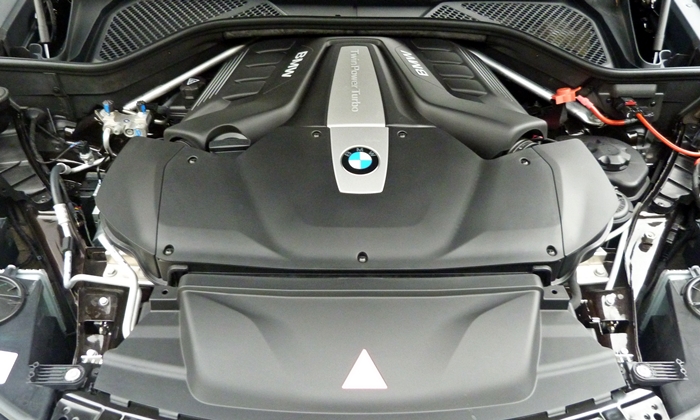
445-horsepower V8 engine burbles nicely at idle, brutally quick when prodded.

With both rows folded, there's almost as much cargo space as in the half-ton-lighter Honda CR-V.
See more 2014 BMW X5 photos
BMW and Land Rover each provided an insured vehicle for a week with a tank of gas.











